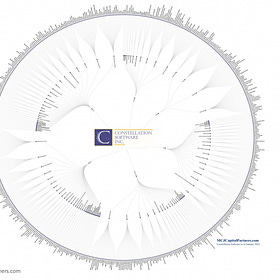Just as we know the magic of compounding regarding financial returns, I believe there is a way to compound impact or impact compounding. However, we can learn critical characteristics or traits from compounding for financial returns to compounding impact returns. Let us dig a bit deeper on this topic.
Two characteristics that immediately stand out when we think about compounding impact returns are a) Patience and b) Commitment. Let us explore these two characteristics in more detail.

Patience is crucial because:
Long-term mindset Vs. Short-term mindset: When discussing impact returns, we want to create societal & environmental impact and not quick fixes fundamentally. Quick fixes can provide the bandage for the short term, but they won’t solve the root causes. To create quality or genuine impact, we should optimize the long-term mindset, which invariably requires patience with our impact/conscious investments.
Delayed gratification: The most substantial benefits may not be immediately visible or measurable. This allows us to humble our approach to creating impact; it is not about quick wins to boost our ego or have gratification, but instead creating long-lasting impact by being flexible and not getting fixated on outcomes and metrics. That leads to another key characteristic: adaptability.
Learning and iteration: Willingness to adjust strategies based on feedback and emerging evidence.
Flexibility: Ability to respond to changing circumstances or unexpected outcomes.
Allowing for systemic change: Fundamental shifts in complex systems rarely happen quickly. When investing for impact, we must see things from a holistic or systems perspective - recognizing how different system elements interact and influence each other. There will be unintended consequences, so we need to focus on a systems approach. Also, just like financial returns go up and down, I expect impact returns to be affected occasionally because of geopolitical and macroeconomic reasons. The idea is not to focus on macro-economic factors but rather on macro-economic factors.
“If we optimize the business for impact, we could achieve higher profit maximization because impact maximization takes care of the profits and the well-being of society and planet Earth. The well-being of society should ideally lead to better and resilient free cash flow and profitability with lower risk than capitalism, which is short-sighted. I don’t have proof that impact maximization leads to profit maximization, but there is no proof that impact maximization won’t lead to profit maximization. But in theory, I firmly believe in impact maximization.
Prove me otherwise!”
Business for Peace [adapted & modified quote]
Commitment is essential because:
Consistency: We must put in sustained effort over time to create impact. It can be a half-baked attempt for a short period, but we must do it consistently with a true commitment to creating long-term impact value.
Resilience: There will be setbacks or periods of slow progress that require perseverance, and there will be times when the impact value will be eroded. However, this doesn’t mean that the impact work that we have put together is useless.
Maintain a Long-Term Mindset: Taking a patient, long-term view is essential for both financial and impact compounding. Resist the temptation for short-term gains to maximize long-term, compounding benefits.
Reinvest Impact: Similar to reinvesting financial returns, continuously reinvesting the time, resources, and energy into sustaining and growing the impact initiatives allows that impact to compound.
Other vital characteristics to compound impact are:
Minimize Friction and Leakage: Just as high fees and taxes erode financial compounding, impact compounding can be undermined by operational inefficiencies, bureaucratic hurdles, or other forms of "friction" that prevent full reinvestment of the efforts.
Pursue Higher-Impact Activities: Seeking out the highest-leverage, highest-impact initiatives and programs, similar to pursuing investments with higher returns, can accelerate the compounding of the social or environmental impact.
Capital allocation: To create impact, we need to learn the capital allocation strategies - what capital allocation strategies we have in our hands to create impact. I argue that capital allocation is the most important but yet the most ignored trait, and no one in impact or conscious investing talks about it. There are five capital allocation strategies to create financial returns - buybacks, acquisitions, investing in existing ops, dividends, and paying off debts. Drawing parallels between financial and impact capital allocation strategies is an exciting approach. Let's explore how we can translate these five financial strategies into the realm of creating impact returns.
These characteristics work together to create an environment where impact can compound effectively. Patience and commitment provide the foundation, allowing systems thinking, adaptability, minimizing friction, and capital allocation to drive sustained, growing impact over time.
By applying similar principles that drive financial compounding, we can maximize the compounding of our social, environmental, and other forms of positive impact over time. The key is to start now, reinvest our efforts, and be patient as our impact grows exponentially.
I promise to write an article on Capital Allocation strategy to create impact returns. This is a fascinating topic, and I want to explore it further. Please read my other piece on »
Capital Allocation
For the last few months, I have been diving deep into the intersection of private and public markets, and I keep coming back to the idea of micro-acquisition funds or serial acquirers. These are a hybrid of venture studios, conglomerates, acquisition arms, and capital allocators like Warren Buffet and Henry Singleton.
What do you think about impact compounding?
Do you know books or resources on impact compounding or capital allocation strategies to optimize for impact? Please recommend me at sagar@firstfollowers.co. I am looking for resources to investigate, and to my surprise, I couldn't find anything.
I want to leave you with a fascinating book: “The Clock of the Long Now” by Stewart Brand. It discusses long-term thinking, which I think is very important when we consider compounding impact returns and finding the right capital allocation strategies to optimize for impact returns.
Additionally, I will leave you with this podcast, Investing by the Books #62 Moritz Sitte on The Clock of the Long Now.
This article was originally published on the IDEX Accelerator substack.
Sign-off for humanity,
ST






